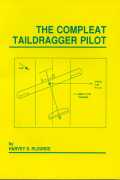
CUB HOME PAGE > COMPLEAT TAILDRAGGER
Taming the wild taildragger

The Compleat Taildragger Pilot (Harvey Plourde)
I was very slow to master the Piper's Cub interface with the ground, so my instructor recommended that I buy this book. It's a "homebuilt" -- published by the author's widow, peppered with typographical errors (Cessna's as the plural of Cessna, it's as a possessive) and illustrated with simple but useful stick figures to show how taildraggers and trikes differ with respect to their center of gravity, tendency to swap ends, and sensitivity to crosswinds. Harvey Plourde obviously had to cope with student pilots like me, and I imagined him chalking those figures on the blackboard. They were very useful.
Harvey learned to fly in an Aeronca Champ in 1953. He served in the USAF as an aircraft instrument mechanic, then got an engineering degree in 1959. He worked in the aerospace industry for 30 years, meanwhile flying with the New Hampshire Civil Air Patrol as its chief check pilot. To judge by the book, a lot of his work involved transitioning new CAP pilots from trikes to taildraggers such as the Cessna Bird Dog and the DeHavilland Beaver.
Some of his opinions contradict my own training. For example, Plourde is dead set against high-speed taxis, which he regards as dangerous in the extreme. Yet my instructor (not the one who recommended the book) got me ready for my first takeoff by having me charge down a private grass strip with the Cub's tail in the air. Of course he was 23, just out of the Marines, with very sharp reflexes. As Plourde points out, the CFI is in the aircraft for two reasons: first, he is training the student; and second, he is ready to rescue the student from any wrong move. No doubt Brian was confident that he could head off a wild swing into the weeds or prevent me from putting the Cub on its nose. (I am less sure of the second. Six months after Brian departed from my life, a student making a high-speed taxi in that same Cub -- Four One Victor, formerly the property of the Massachusetts Air Guard--hit the brakes and wrecked it utterly.)
Harvey is especially good on the presentation of P-factor -- how the gyroscope of a spinning propeller can change one's direction, and which which affects a taildragger more than a trike. In a less theoretical vein, the discussion of crosswind landings is something that the experienced pilot can benefit from reviewing from time to time.
There's also a suggested curriculum for transitioning from trikes to taildraggers -- probably the usual circumstance now, when most training is done in one or another Cessna trike. Astonishingly, Harvey's suggested minimum is 10.5 hours -- for a certificated pilot! That must cause some head-shaking among the Old Pilots who soloed the Piper Cub in 8 hours.
This should be part of the basic library for anyone who flies (or hopes to fly) a taildragger. Now available only in a secondhand copy, but usually at reasonable prices.
Question? Comment? Newsletter? Send me an email. Blue skies! -- Dan Ford

Other websites: the Warbird's Forum | Daniel Ford's books | Facebook | Sail Alaska's coast | Reading Proust
Posted August 2019. Websites © 1997-2019 Daniel Ford; all rights reserved. This site sets no cookies, but the Mailchimp sign-up service does. So does Amazon if you click through to that store.